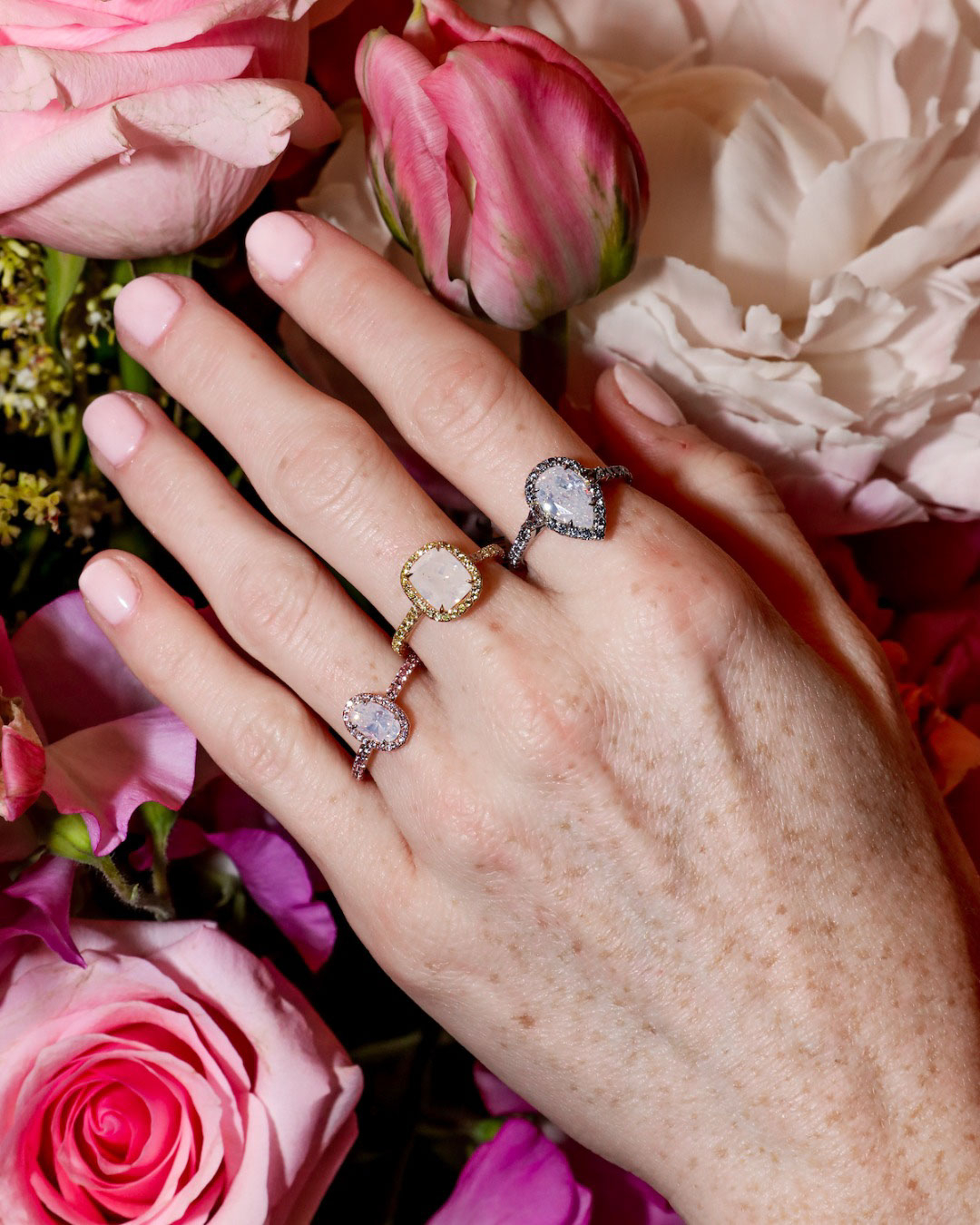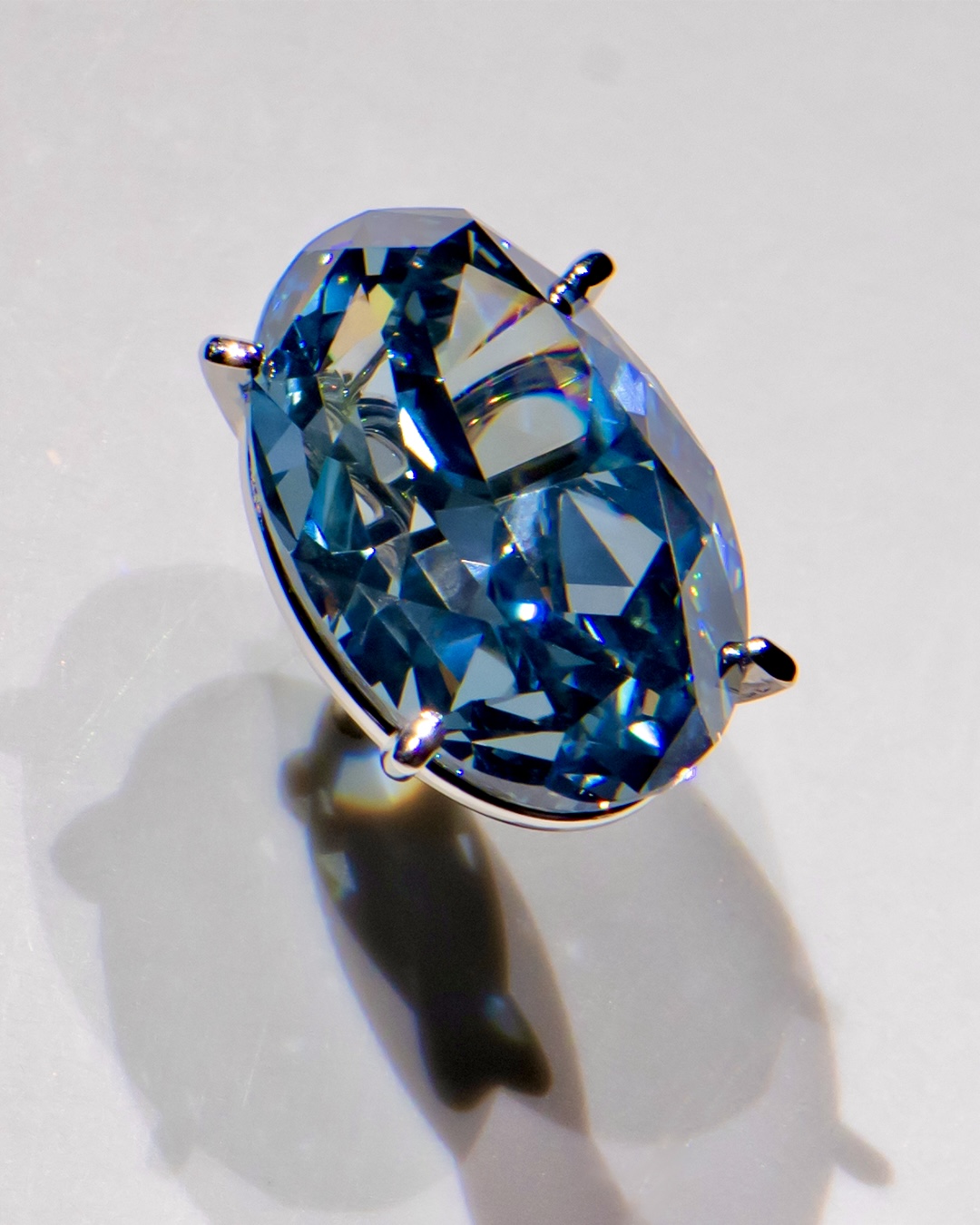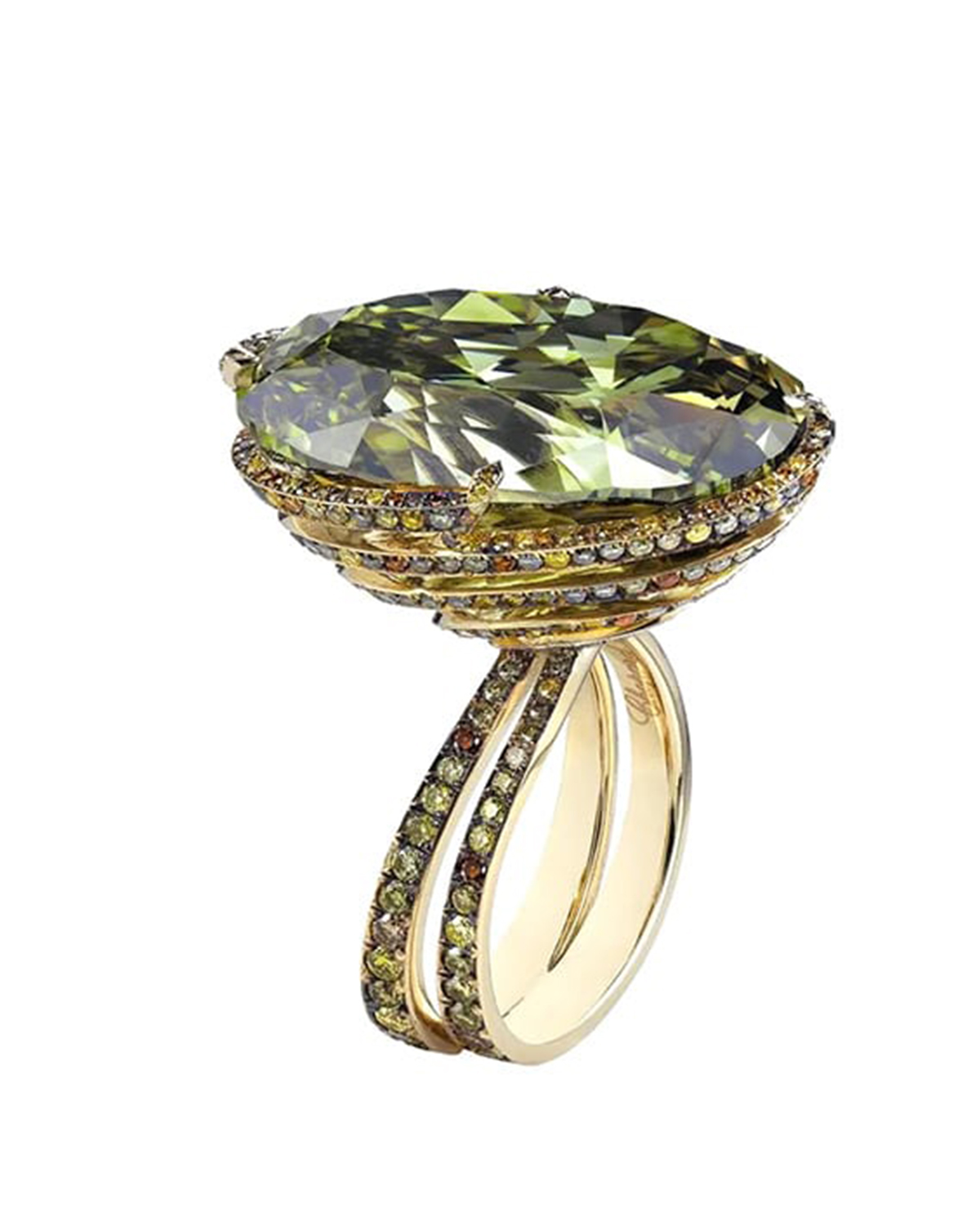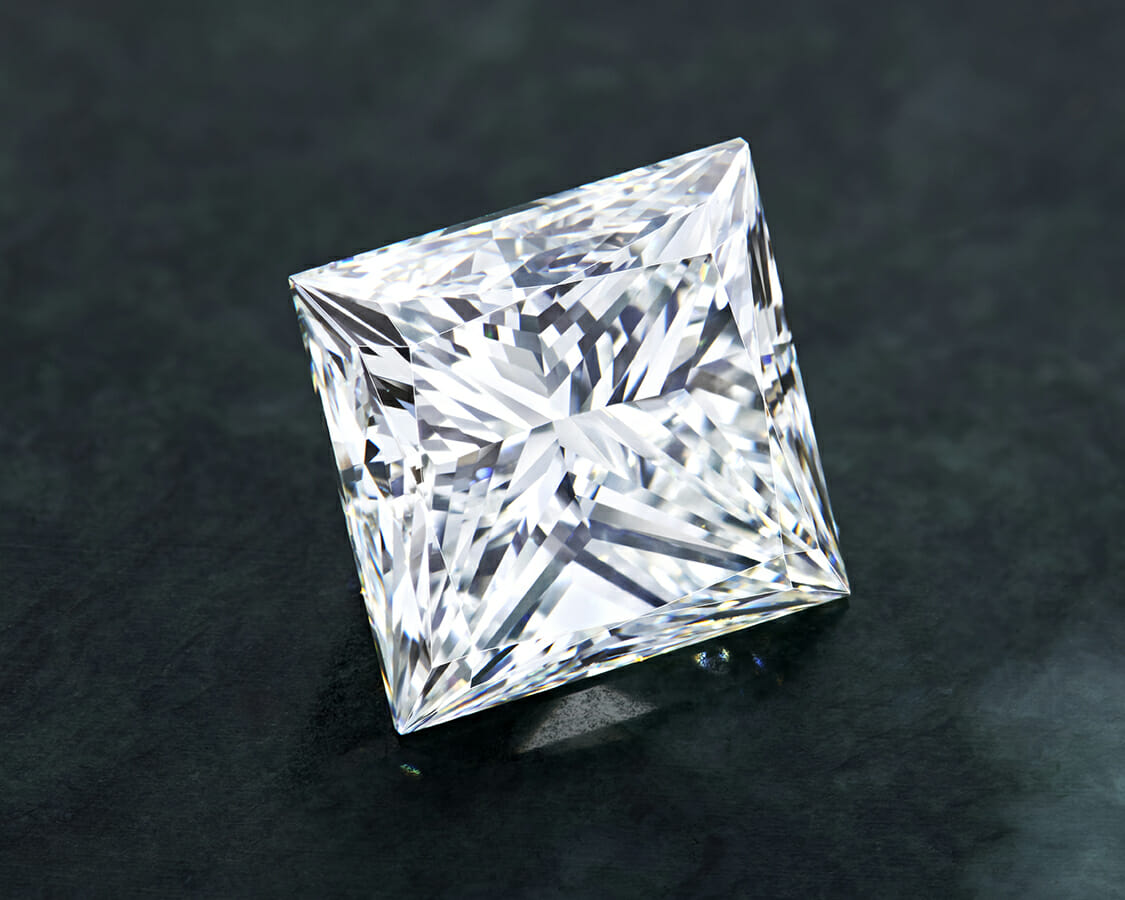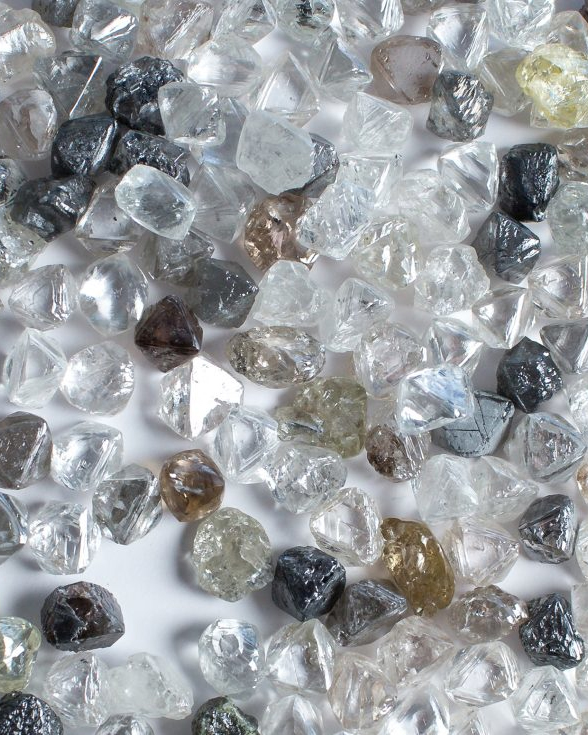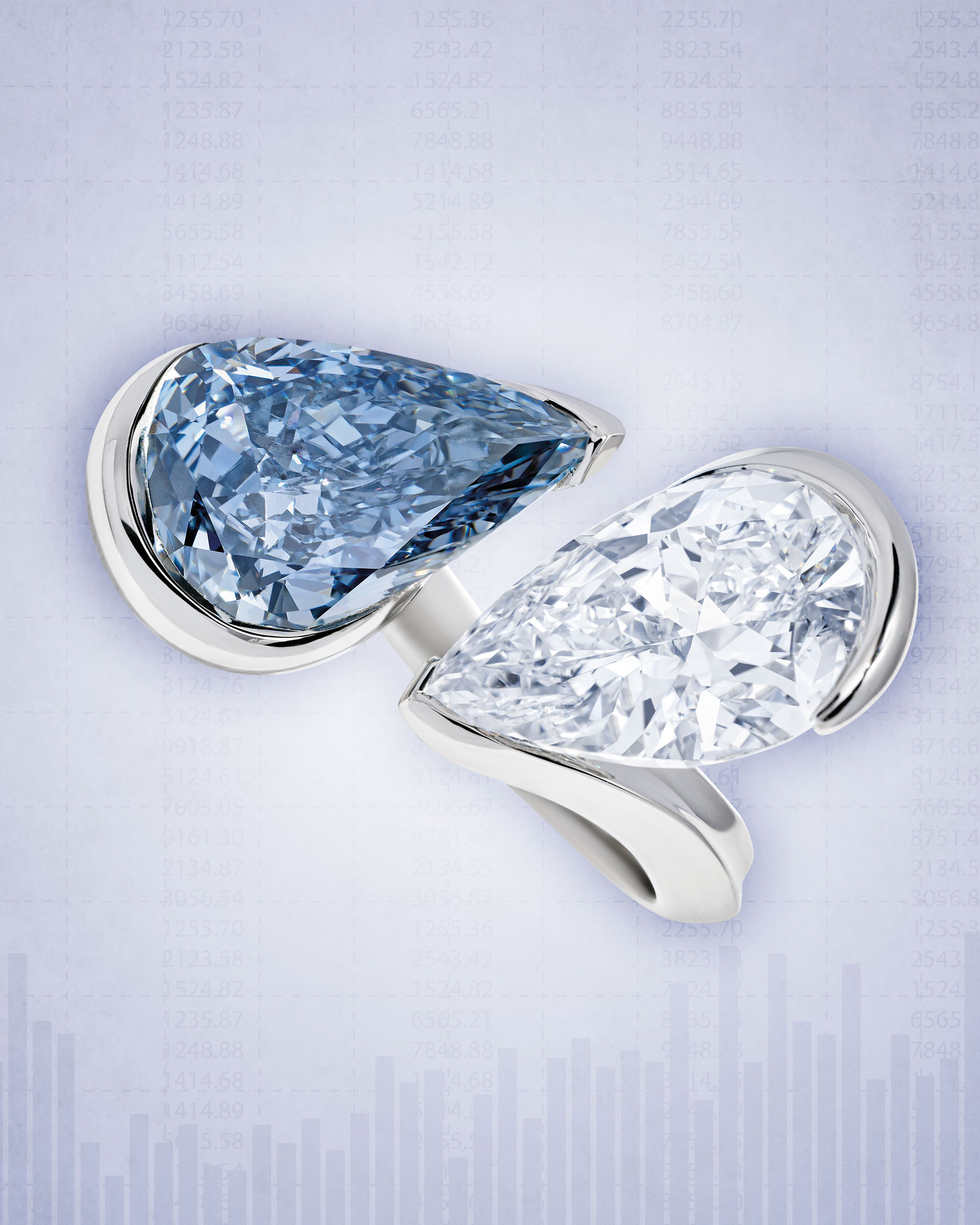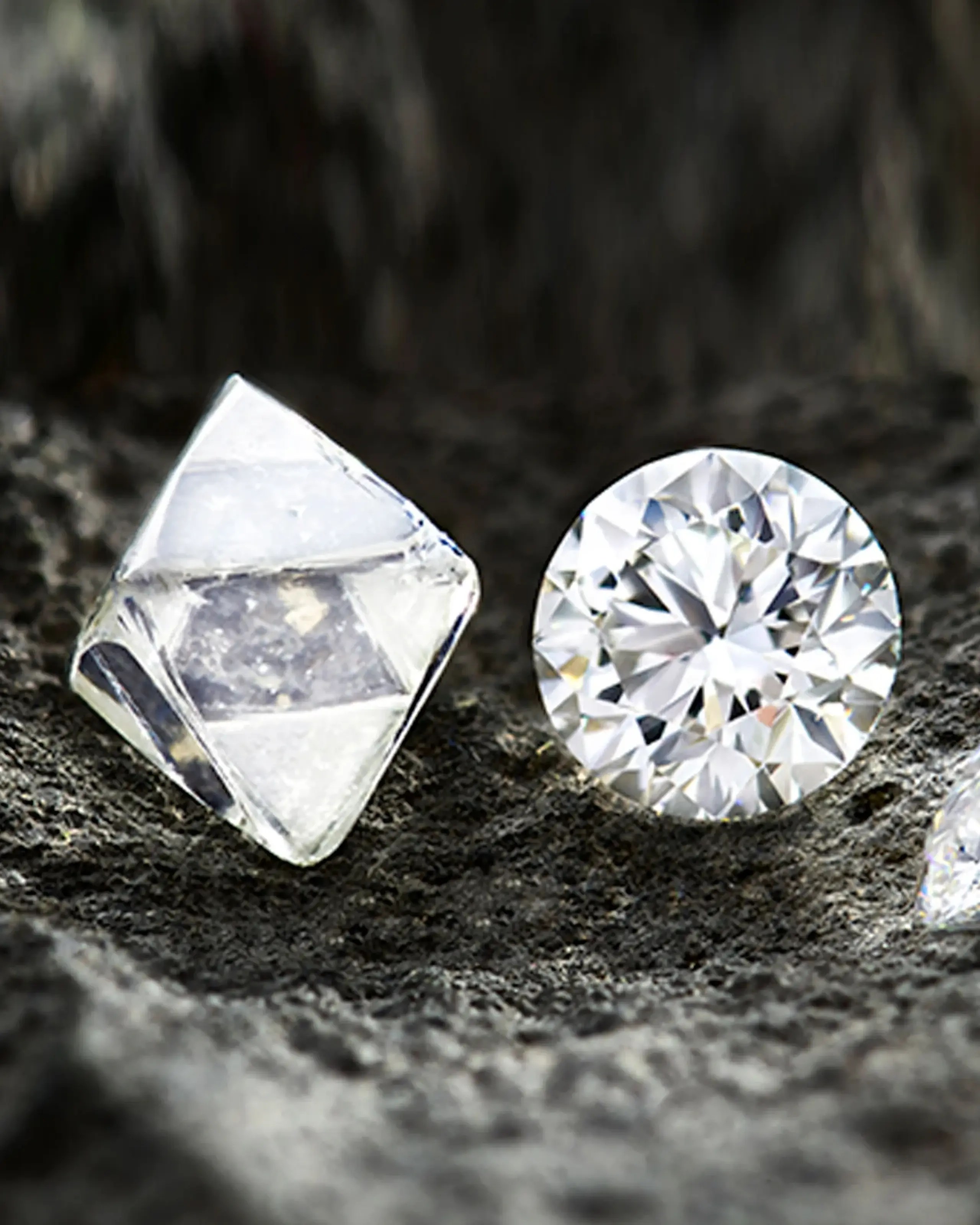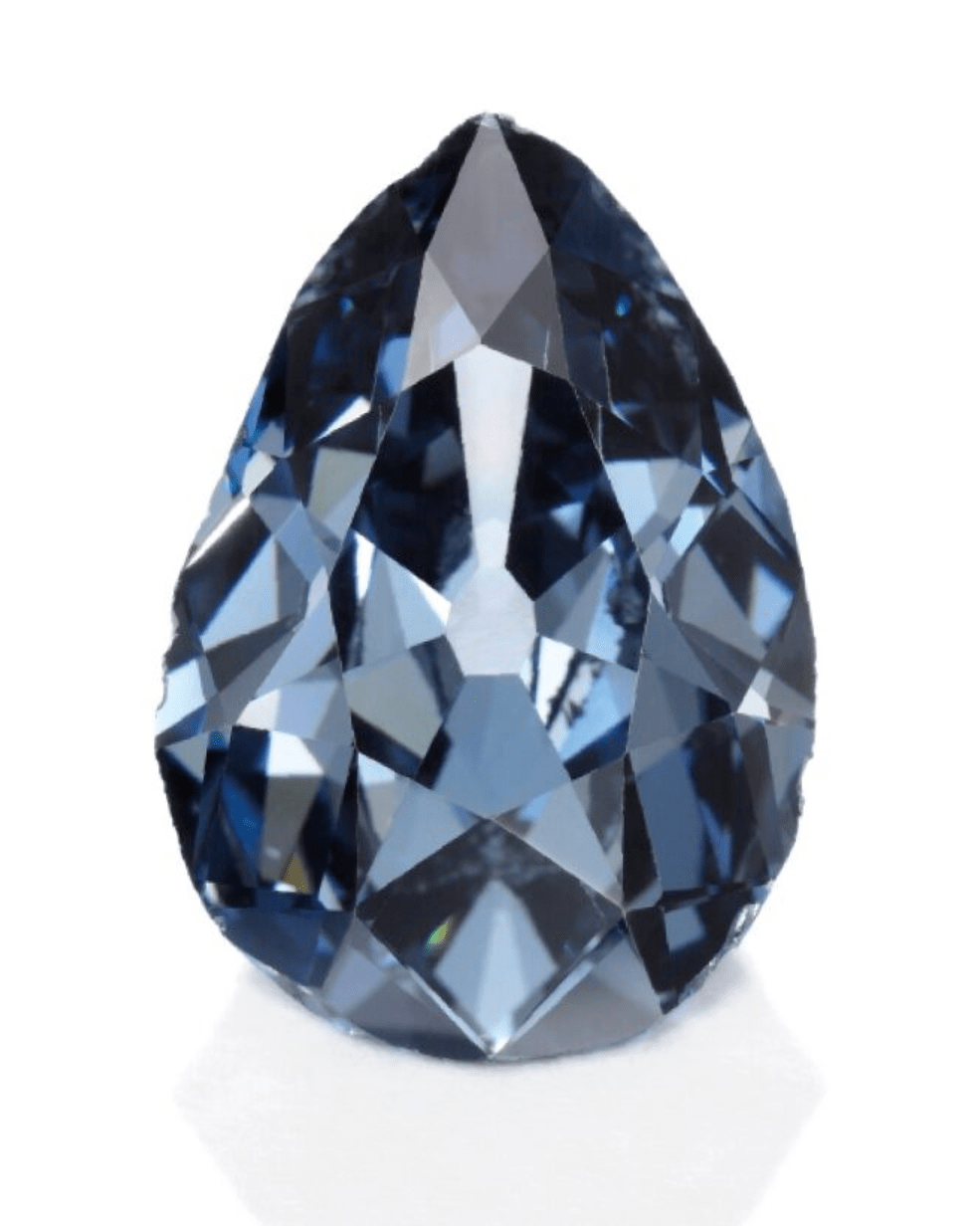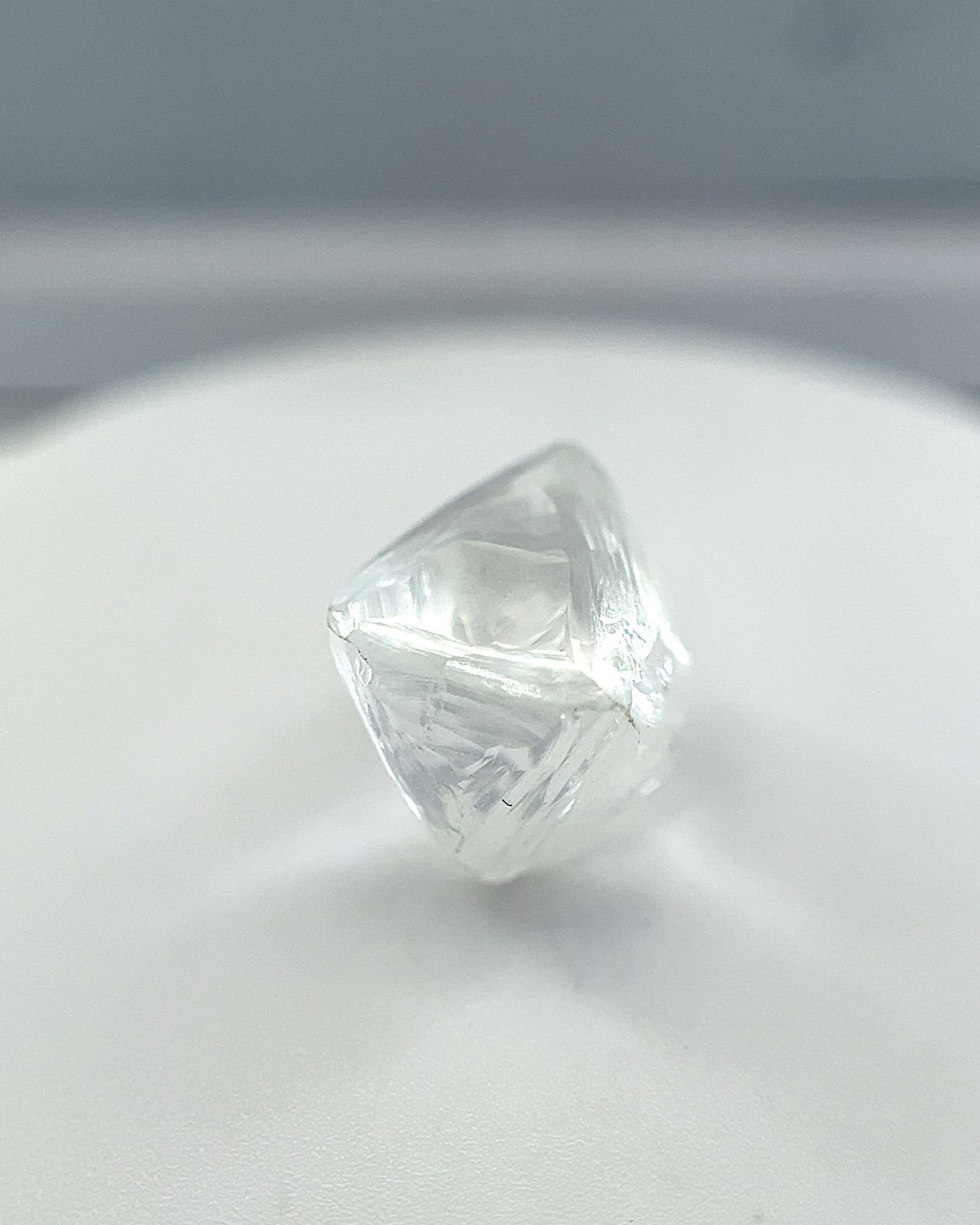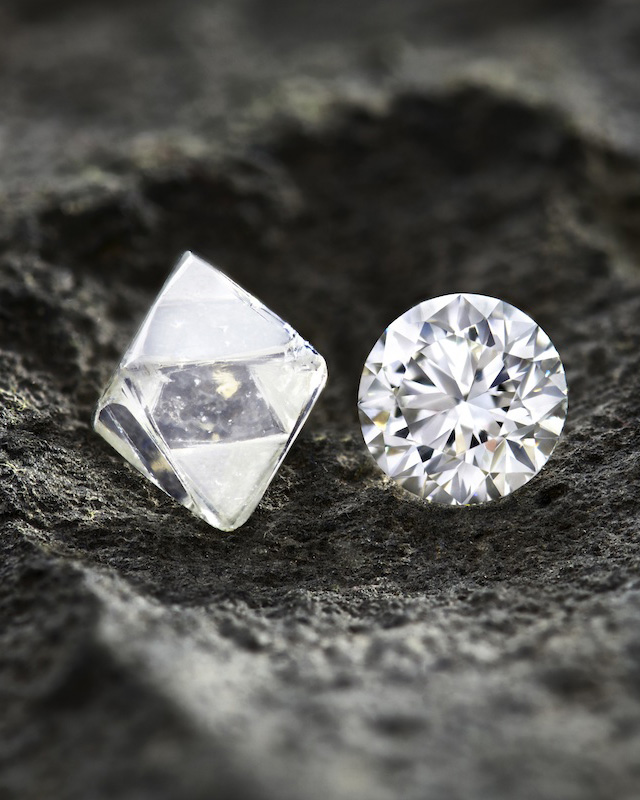
Diamond FAQs
Our diamond FAQs dispel some of the myths around natural diamonds: their rarity, environmental impact and value.
Did De Beers invent the diamond engagement ring?
No, De Beers did not invent the diamond engagement ring. The tradition of giving engagement rings dates back thousands of years, long before De Beers’ famous 1947 “A Diamond is Forever” campaign. Ancient Romans are believed to have exchanged rings as a symbol of betrothal, and in 1477, Archduke Maximilian of Austria gave Mary of Burgundy a diamond engagement ring—one of the earliest documented uses of a diamond for this purpose. During the Victorian era, engagement rings often featured diamonds alongside other gemstones in elaborate designs. By the late 19th century, diamond engagement rings were already appearing in Tiffany & Co. catalogues, further indicating that the practice was well established before De Beers entered the picture. While De Beers helped make the diamond engagement ring more iconic in the modern era, the tradition itself has deep historical roots.
Is a diamond chain a good investment?
High-quality pieces from respected jewelers or rare vintage chains can hold or even increase in value.
What should I look for when buying a diamond chain?
Check the craftsmanship, diamond quality, weight of the gold, and the seller’s reputation. Make sure it fits your lifestyle and budget.
Do diamond chains need regular maintenance?
Yes. Regular inspections (especially for loose stones or damaged links) and occasional professional cleanings help keep your chain in great shape.
How do I clean a diamond chain?
Gently soak it in warm water with mild soap, use a soft brush to clean around the stones, then pat dry with a lint-free cloth. Avoid harsh chemicals and ultrasonic cleaners unless advised.
How can I tell if a diamond chain is high quality?
Look for well-set stones, strong clasp mechanisms, solid (not hollow) links, and reputable materials like 14k/18k gold or platinum. Check if the diamonds come with a grading report (cut, clarity, color, carat).
Can I wear a diamond chain every day?
Absolutely—as long as it’s durable and well-made. For daily wear, consider the setting security and choose styles that aren’t too delicate.
What types of diamond chains are most popular?
Popular styles include Cuban link, tennis chains, rope chains, and baguette-set designs. Chunky pavé-set links and custom pendants are trending in both high fashion and streetwear.
Are diamond chains unisex?
Yes! Diamond chains are popular across all genders. Style preferences vary, with men often favoring thicker, chunkier styles and women gravitating toward delicate or layered looks—but there are no rules.
What is a diamond chain?
A diamond chain is a necklace or bracelet featuring diamonds either set directly into the links or embedded in pendants or charms. They range from subtle, minimalist styles to bold, statement pieces.
What copy should I use when sharing these assets?
We encourage you to promote the real, rare, responsible values of natural diamonds when sharing these assets. “Natural diamonds are finite geological marvels formed billions of years ago. They are as real as the essence of time and creation, having predated all life on Earth. True rarity lies in the finite and unique. Natural diamonds are scarce treasures, discovered only in the depths of predominantly remote regions of the Earth. The magnificence of a natural diamond is enhanced by the responsible journey through ethical mining and sourcing practices that have a positive global impact on people and our ecosystems.”
Are the assets evergreen?
Yes! You can use these assets in perpituity. There are no expirations for their use.
Who should I credit when using the downloadable assets?
Example Credit:
Image courtesy of Natural Diamond Council [hyperlink to naturaldiamonds.com]
Can I share the downloadable assets on my communication channels?
Yes! We encourage you to download these assets and and promote the story, facts, and beauty of diamonds across your communication channels and in-store.
Are the downloadable assets high-resolution for print-use?
A variety of assets are available in hi-res for print use, including the “Botswana” and “Northwest Territory, Canada” assets.
What types of downloadable assets are available?
The free downloadable assets consist of social and point of sale assets, ranging from images to videos to fact sheets.
Can I use the assets for paid advertisements?
No, these assets cannot be used for paid advertisements. However, if you have a special request, please email info@diamondlearningcenter.org
Are the downloadable assets customizable?
No, these assets are not customizable. They are preformatted in various aspect ratios and cannot be altered or modified based on usage rights.
Are they sustainable?
The natural diamond industry supports the livelihood of 10 million people globally.
The world’s leading diamond producers generate $16 billion in positive socioeconomic and environmental benefits each year in the countries where they operate, with 80% of that staying in local communities. The discovery of natural diamonds has completely transformed countries like Botswana and remote areas such as Canada’s far North. Through a commitment to sustainability, the diamond industry continues to invest in the future of these communities while protecting the environment for generations to come.
The wealth generated by laboratory grown diamond companies largely benefits only a select few venture capitalists and investors who have yet to demonstrate socioeconomic contributions similar to the natural diamond industry.
*Analysis conducted by Trucost, part of S&P Global, based on 2016/2017 data.
What do they symbolize?
The word ‘diamond’ comes from the Greeks, who named the stone ‘adamas,’ meaning unbreakable or unalterable.
Since their discovery almost 4,000 years ago, natural diamonds have fascinated humans with their unique properties that were previously unseen. They immediately came to symbolize strength, resilience, and power. Ancient Greeks then named them ‘adamas’, meaning unbreakable, just like love. Mythology also sees Cupid’s arrows tipped with diamonds, as a diamond was said to aid in falling in love. The first known diamond engagement ring was given in 1477, sparking the tradition and cementing their status as the ultimate symbol of love and heirloom, a sentiment that has spread across cultures and through time.
What is their environmental impact?
The environmental impact of a one-carat natural diamond from mine to finger is about the same as the environmental impact of manufacturing three smartphones.
Researchers are using the rocks in which diamonds are found, called kimberlite, to absorb carbon dioxide from the atmosphere in a ground-breaking research program with the aim of reaching carbon neutrality within this decade. Also, triple the amount of land natural diamond companies use is set aside for environmental conservation.
There are no toxic chemical byproducts used in natural diamond recovery because once they are removed from the ground, diamonds are easily extracted from the host rock. The leftover rock is then stored on-site and used when the mine is closed to return the land back to its original state.
Lab grown diamonds are produced using electricity and machinery to recreate Earth’s conditions and generate temperatures of 2,700 Fahrenheit and pressure of 1.5 million pounds per square inch. They also need large amounts of water to cool down the reactors. Around 60% of LGDs are manufactured in China and India, countries that rely heavily on coal. There are also production facilities that have managed to use hydropower to replace fossil fuel but that is still a limited option for most of the laboratory created diamond market.
Are they rare and valuable?
The total amount of natural diamonds one carat and larger recovered in a year would only fill one exercise ball.
The value of a natural diamond derives from its rarity as a finite, natural gemstone. This rarity and finiteness make natural diamonds valuable. Over the last 50 years, natural diamonds have shown to appreciate in price by approximately 2-3% on average per annum. Natural diamonds retain inherent value over time, making them an incredible heirloom and an impactful choice for an engagement ring. However, like other manufactured products, man-made diamonds can be replicated in potentially unlimited quantities. Between 2015 and 2024, the prices of some lab grown diamonds fell by more than 80%.
How are they created?
Natural diamonds are formed by the heat and pressure of the Earth, from 1 to 3 billion years ago, making a natural diamond the oldest thing you will ever touch.
Natural diamonds are formed deep within the Earth under intense heat and pressure, where pure carbon atoms crystallize into the hardest mineral on Earth, a diamond. The extreme conditions deep within the Earth that create natural diamonds are just the beginning of their journey. After forming about 100 miles below the Earth’s surface, natural diamonds were blasted upwards by ancient volcanoes. As these volcanoes erupted, they trapped the diamonds in molten rock, carrying them to the surface. Today, diamonds are found in the remnants of these ancient volcanoes, known as kimberlite pipes. Natural diamonds are often called “mined diamonds,” although some are recovered without traditional mining. These diamonds are made of pure carbon, formed under extreme pressure and heat over millions of years.
Unlike their natural counterparts, lab grown diamonds are created by humans using machinery and energy to force carbon to crystallize. Lab created diamonds are created using two primary methods: High Pressure High Temperature (HPHT) and Chemical Vapor Deposition (CVD). Although sharing physical properties and optical properties, lab grown diamonds’ quick growth process and different chemical compositions makes them easily identifiable from natural diamonds using a diamond tester. A reputable laboratory, such as the Gemological Institute of America (GIA), can also easily tell them apart using specialized instruments.
Are natural diamonds traceable?
The natural diamond industry is advancing quickly in its efforts to improve transparency through traceability initiatives. By leveraging cutting-edge technology like blockchain, the industry is ensuring that diamonds can be tracked from their source all the way to the final consumer.
What are the working conditions like in the diamond industry?
The natural diamond industry places a strong emphasis on adhering to the highest global standards for working conditions. Members of the Natural Diamond Council (NDC) ensure that labor practices at mining operations are ethical, with a commitment to providing fair wages, safe working environments, and community development. Additionally, the majority of the diamond mining workforce is hired locally, with 99.7% of NDC employees being from the surrounding communities, and nearly one-third of the workforce in the industry are women.
Is the industry stockpiling diamonds to drive-up prices?
No. Contrary to some rumors, the diamond industry is not stockpiling diamonds in an effort to artificially inflate prices. In fact, inventories of rough diamonds declined by 40% in 2021, according to Bain & Company’s data, based on reports from mining companies and the Kimberley Certification process, which governs rough diamond trade. This shows that the diamond supply is naturally limited and not being manipulated to control pricing.
Do natural diamonds benefit their countries of origin?
Yes! The natural diamond industry provides significant socio-economic benefits to the countries in which diamonds are mined. It supports the livelihoods of approximately 10 million people worldwide, with local communities directly benefiting from diamond mining through employment opportunities, social programs, infrastructure investment, and taxes, royalties, and dividends paid to governments. In fact, up to 80% of the value of rough diamonds stays within local communities, which helps stimulate economic growth and social development.
What is the natural diamond industry doing to reduce its carbon footprint and protect biodiversity?
The natural diamond industry is deeply committed to minimizing its environmental impact and contributing to the global effort to combat climate change. Major companies, such as the De Beers Group, have set ambitious goals to become carbon neutral by 2030, while Rio Tinto aims for net-zero emissions by 2050. Moreover, the diamond industry actively works to protect biodiversity. For instance, the areas surrounding diamond mining operations are often preserved and maintained, with many companies investing in sustainable practices that protect large areas of land—far larger than the areas used for mining itself.
Are natural diamonds rare?
Yes! Natural diamonds are incredibly rare, a fact that significantly contributes to their value. Global diamond recovery peaked in 2005, and since then, production has steadily decreased. In 2023, diamond production was 37% lower than in 2005, and the amount of diamonds recovered each year is so small that the entire annual recovery of all diamonds weighing 1 carat or more could fit into just one exercise ball. The formation of diamonds, which takes millions to billions of years, occurs in specific zones of the Earth, making them a finite and precious resource.
What have been the price trends for laboratory grown diamonds?
From 2015 to 2024, the price of laboratory grown diamonds has seen a dramatic decline. For example, a 1.5-carat polished synthetic diamond that cost $10,750 in 2015 is now retailing for just $1,770 in Q3 2024, representing a decrease of over 83%. While the natural diamond market has also experienced price fluctuations, the overall trend over the past 50 years has been upward, with diamond prices rising by an average of 3% per year. This steady increase in natural diamond prices reflects their enduring value, rarity, and demand.
Are all laboratory grown diamonds sustainable?
While laboratory grown diamonds are often marketed as eco-friendly, the reality is more complex. The energy-intensive process required to create these diamonds involves generating temperatures close to 20% of the temperature on the Sun’s surface, which demands significant energy consumption. Furthermore, much of the production takes place in countries like China and India, where coal is a dominant source of electricity. This means that, contrary to some claims, the environmental footprint of laboratory grown diamonds is far from negligible, as they are often powered by fossil fuels.
Can you detect a laboratory grown diamond from a natural diamond?
Yes! Despite having the same physical properties, laboratory grown diamonds are mass-produced in a much shorter time frame, typically only a few weeks. This rapid production process results in unique growth-related patterns that differ from those of natural diamonds, which take millions of years to form under extreme pressure and heat. These patterns are easily detectable using professional verification instruments that can distinguish a man-made diamond from a naturally occurring one.
How are natural diamonds ethically sourced?
The ethical sourcing of natural diamonds is a critical concern, and the industry has taken significant steps to address this. The Kimberley Process, mandated by the United Nations and the World Trade Organization, regulates the global trade of rough diamonds to ensure they are conflict-free. Additionally, organizations such as the Responsible Jewellery Council have implemented third-party audits and certifications to ensure that natural diamonds are sourced responsibly, focusing on fair labor practices, environmental sustainability, and community development.
How do I know whether I’m purchasing a natural or a laboratory grown diamond?
When purchasing a diamond, it’s important to ensure that it is clearly disclosed whether the diamond is natural or laboratory grown. Any organization selling laboratory grown diamonds is legally required to inform customers that the diamonds are man-made and must use proper terminology when describing the stones. Consumers can also ask jewelers to verify the origin of the diamond to ensure they are purchasing what they intend.
What is a natural diamond?
A natural diamond is a rare and finite mineral formed by nature, consisting of a crystalline structure of pure carbon atoms. Known for being the hardest naturally occurring substance on Earth, natural diamonds are celebrated for their incredible durability, brilliance, and exceptional rarity. Unlike lab grown diamonds, which are man-made, a natural diamond refers specifically to a gemstone formed deep within the Earth over billions of years through extremely high temperature and high pressure. When shopping for diamonds or diamond jewelry, it’s important to note the word “diamond” used alone always means a natural diamond and not a lab grown diamond or diamond simulant.
Most natural diamonds range in age from one to three billion years, with some rare specimens being over 3.5 billion years old, making them older than humans and dinosaurs.
Natural diamonds are widely used in fine jewelry, especially in diamond engagement rings, and are known for their timeless beauty and value. Their unique formation process makes each natural diamond distinct and irreplaceable.
What is the actual value of natural diamonds?
Like other natural materials, how much natural diamonds cost is based on how rare they are to find in nature. The rarer the natural diamond, the more valuable it will be. Over the last 35 years, natural diamond prices have been shown to appreciate by approximately 3% annually. In its 2019 Global Diamond Industry Report, Bain & Co. found that the diamond market has grown thrice over the past 50 years.
How old are diamonds? Most natural diamonds are between 1 and 3 billion years old. Diamonds form deep within the Earth under intensely high temperatures and pressure, causing carbon atoms to crystallize before being transported to the Earth’s surface by powerful volcanic eruptions, such as kimberlite and lamproite eruptions. Although diamond formation occurs far beneath the Earth’s surface, these eruptions are rare yet immensely powerful, carrying diamonds from the Earth’s mantle to locations where they can be recovered.
These rare and precious gemstones are likely the oldest things you will ever touch, having formed long before any life existed on Earth. The oldest diamonds that have been dated, found in Canada, are 3.7 billion years old.
What is the environmental impact of natural diamonds?
The carbon footprint of a 1-carat natural diamond from mine to finger is approximately the same as making one Macbook computer. In large-scale natural diamond mining operations, three acres are conserved for every acre of land used, protecting around 1,000 square miles of ecosystems, wildlife, and endangered species in Australia, Botswana, Canada, South Africa, and Tanzania. The diamond mining industry is making strong strides in carbon emissions reduction to achieve carbon neutrality to combat climate change, utilizing eco-friendly, renewable energy sources such as wind farms and hydropower and pioneering carbon capture technology with kimberlite rock (the source of diamonds) naturally absorbing and storing CO2. Leading natural diamond mining companies recycle 84% of water usage in the mining process and 99% of the waste produced is rock. There are no toxic chemical bi-products from natural diamond mining because once diamonds are removed from the ground, they are easily extracted from the host rock.
Why is it more accurate to refer to natural diamonds as natural instead of mined?
The terms “mined diamonds” or “earth-mined diamonds” can be confusing and potentially misleading. Not all natural diamonds are actually mined. Some diamonds remain locked deep within the Earth, unreachable by current mining technology, while others are pushed to the Earth’s surface by natural forces such as volcanic eruptions and recovered without traditional diamond mining processes.
For jewelers and consumers alike, it’s important to understand that the term “natural” more accurately describes a diamond’s true origin, regardless of how it is recovered. According to the Federal Trade Commission’s Jewelry Guides, terms such as “real,” “natural,” “genuine,” and “precious” are specifically reserved for diamonds that have naturally formed in the Earth, whether or not they are extracted through mining.
Using “natural diamond” instead of “mined diamond” helps avoid confusion and ensures that the true nature of these precious stones is accurately represented within the diamond industry.
Aren’t diamonds just a product of good marketing?
Human fascination with diamonds goes back millennia, long before diamond marketing existed. It is said that the tips of Cupid’s arrow were dipped in diamonds. Archduke Maximilian of Austria gave the first diamond engagement ring on record in the imperial court of Vienna in 1477. And let’s not forget the great American classic, Gone With the Wind, which featured a diamond engagement ring two decades before the famous slogan ‘A Diamond is Forever’ was coined.
Is the diamond industry a monopoly?
No. There is no monopoly in today’s diamond market. Spread across four continents, today’s largest diamond producers are located in Canada, Africa, Siberia, and Australia, and they are either publicly traded corporations or state-owned enterprises. Today, no company has a majority market share of diamond production, which means there is no possibility of stockpiling or artificial pricing.
Are diamonds rare?
Yes. Natural diamonds are a finite and rare natural material among Earth’s top 10 rarest natural materials. The number of newly recovered diamonds peaked in 2005, so fewer and fewer diamonds have been found every year since. Over the last 140 years, almost 7,000 kimberlite pipes have been analyzed by geologists, yet approximately only 60 of these were deemed suitable for rough diamond recovery. The annual recovery of all natural diamonds 1-carat and above can fill just 1 exercise ball.
Colored diamonds, called fancy color diamonds, are even rarer, due to the unique geological processes that form them. The rarest hues, such as blue diamonds and red diamonds, can sell for over $1 million per carat due to their exceptional rarity.
Are colored diamonds real?
Yes, natural colored diamonds can be real, but not always. Natural diamonds can form in nearly every color of the rainbow and these rare gemstones, known as Fancy Color Diamonds, are exceptionally valuable. Unlike traditional colorless diamonds, evaluated based on GIA’s color grading scale from D to Z, Fancy Color Diamonds are evaluated based on tone, hue, and saturation. This includes all colors other than colorless diamonds to light yellow diamonds or brown diamonds. The rarest hues, such as blue and red diamonds, can sell for over $1 million per carat due to their exceptional rarity.
The natural colors of diamonds result from unique geological processes. For instance, blue diamonds owe their color to boron atoms trapped during formation, while green diamonds are colored by exposure to natural radiation deep within the Earth. Black diamonds, though not as “colorful” in the traditional sense, are considered a fancy color because their deep, opaque appearance sets them apart from standard colorless diamonds. Their dark, sometimes jet-black, appearance is due to the presence of inclusions and fractures within the diamond, which absorb light rather than refracting it.
However, not all colored diamonds are natural. Some are treated to mimic these hues, and while they may appear similar, they don’t hold the same value. Similarly, lab grown diamonds can be made in various colors but lack the rarity and intrinsic value of natural Fancy Color diamonds. To confirm a diamond’s authenticity and natural origin, always request an independent grading certificate that verifies its natural status and color origin.
Is diamond mining dangerous to people?
No, modern diamond mining is not inherently dangerous to people. In fact, reputable diamond mining operations prioritize the safety and well-being of their employees. These companies implement strict safety protocols and invest heavily in creating safe working conditions. As a result, diamond mining provides high-quality, high-paying career opportunities in remote regions where job options are limited.
Leading diamond producers put the health and safety of their workers first, with many offering competitive wages. Employees of top diamond mining companies earn, on average, 64% more than the national average salary, and in many cases, they receive nearly five times the living wage in their country. These positive economic impacts demonstrate that the modern diamond mining industry not only ensures safety and respects human rights, but also helps improve the livelihoods of local communities.
Do laboratory grown diamonds come with grading reports?
While some diamond grading laboratories do not certify laboratory grown diamonds, reputable organizations such as the Gemological Institute of America (GIA), the International Gemological Institute (IGI), and the Gemological Science International (GSI) provide detailed grading reports for lab grown diamonds. These reports clearly indicate that the diamond is laboratory grown, not natural. It’s crucial to be cautious of non-third-party grading reports that may fail to clearly disclose a diamond as lab grown.
Are laboratory grown diamonds more socially conscious than natural diamonds?
No. The natural diamond industry supports the livelihoods of 10 million people worldwide, with leading diamond producers generating $16 billion in benefits annually for employees, communities, and the environment. Notably, 80% of these benefits are retained by local communities, fostering long-term economic growth and sustainability. In contrast, the wealth created by lab grown diamond companies primarily benefits a select group of venture capitalists and investors. These companies have yet to demonstrate the same level of socioeconomic contributions to local economies or communities, highlighting the significant difference between the economic impact of natural diamonds and synthetic diamonds.
What is the environmental impact of laboratory grown diamonds?
Not all lab grown diamonds measure up to sustainability claims, as their production involves a significant environmental footprint, including high carbon emissions, energy consumption, and water usage. To create lab grown diamonds, manufacturers replicate the extreme conditions found deep within the Earth which form natural diamonds, using two main methods: High Pressure High Temperature (HPHT) and Chemical Vapor Deposition (CVD). Both processes require immense electricity to generate temperatures between 1,500°C (2,700°F) and pressures of 1.5 million pounds per square inch. The energy consumption required for these conditions results in a considerable carbon footprint, especially in regions like China and India, where coal is still the primary energy source. Some facilities use hydropower as a cleaner alternative, but this is still limited in many areas. Additionally, the production of lab grown diamonds requires large amounts of water to cool the reactors, further contributing to concerns about water usage in regions with limited water resources.
Are lab grown diamonds unique?
Laboratory grown diamonds, often referred to as lab created diamonds, are not unique. These man-made diamonds are produced in controlled environments, allowing for large-scale production in unlimited quantities. Typically, they are created using two methods: High Pressure High Temperature (HPHT) and Chemical Vapor Deposition (CVD). These techniques replicate the natural processes that form natural diamonds deep within the Earth, but in a much shorter time frame.
Lab grown diamonds are manufactured to the exact specifications set by the producing company. While they share the same chemical composition and physical properties as natural diamonds, natural diamonds result from a truly incomparable journey. No two natural diamonds are alike, each one carrying its own history and story.
What is the difference between lab grown diamonds and natural diamonds?
Laboratory grown diamonds are not identical to natural diamonds, despite their similar appearance. Lab grown diamonds are mass-produced in factories, primarily located in China, India, and Singapore, using methods like Chemical Vapor Deposition (CVD) or High Pressure High Temperature (HPHT). The rapid, artificial production process results in distinct chemical compositions and growth patterns that differ from those of natural diamonds. These unique characteristics make lab grown diamonds easily detectable by experts or with specialized equipment. While they may look almost identical to natural diamonds to the naked eye, their internal structure and formation process are not the same.
Do lab grown diamonds hold value?
Lab grown diamond prices have dropped significantly, from 80% of the cost of natural diamonds in 2016 to less than 20% by 2024. This dramatic price reduction is largely due to the ability to produce lab grown diamonds in unlimited quantities using methods like Chemical Vapor Deposition (CVD) and High Pressure High Temperature (HPHT). Unlike natural diamonds, which are rare, lab grown diamonds are priced based on production costs and retail markup. As production techniques improve and scale, their value is expected to continue declining until they reach a stable price point.
What is a lab grown diamond?
A laboratory grown diamond, also known as a synthetic diamond, lab created diamond, or man-made diamond, is a man-made gemstone that mimics the physical properties and optical properties of a natural diamond. Unlike natural diamonds, lab grown diamonds can be produced in unlimited quantities. Lab grown diamonds are created using advanced technologies such as High Pressure High Temperature (HPHT) or Chemical Vapor Deposition (CVD), which simulate the conditions under which natural diamonds form deep within the Earth’s mantle.
Why are natural diamonds more expensive than lab grown diamonds? Are they worth it?
Natural diamonds cost more due to their rarity and the complex geological processes that form them. These gemstones, especially larger diamonds with exceptional color and clarity, are incredibly rare. They are created over billions of years under extremely high pressure and temperature deep within the Earth’s crust. This scarcity makes natural diamonds highly valuable in the diamond market and determines the price difference between lab grown and natural diamonds.
On the other hand, lab grown diamonds (also known as synthetic diamonds, lab created diamonds or man-made diamonds) can be produced in virtually unlimited quantities, through Chemical Vapor Deposition (CVD) or High Pressure High Temperature (HPHT)processes. With modern technology, lab diamonds can be created in any carat weight, color grade, or clarity grade, making them more affordable than natural stones. The price of lab grown diamonds is primarily determined by production costs and profit margins, rather than rarity.
When comparing the two types of diamonds on the market, there is also a difference in diamond price trends over time. Unlike natural diamonds, which are a finite resource, lab grown diamonds do not appreciate in value over time. In fact, as production processes become more efficient and competition increases, the value of lab grown diamonds tends to decrease. Historically, natural diamonds have shown an average annual appreciation of about 3%, making them a stable, long-term investment with resale value.
For those seeking a truly unique, rare, and enduring diamond engagement ring or piece of jewelry, natural diamonds are an exceptional choice. They not only hold their value but also symbolize a timeless connection to the Earth’s history and natural beauty.
What determines the price of a diamond?
The value of a diamond is primarily determined by its rarity, which is reflected in the 4Cs of diamond grading, the four benchmarks that determine a diamond’s value, developed by gemologist at the Gemological Institute of America (GIA):
- Carat Weight: Larger diamonds are rarer and exponentially more valuable. The more carat increases,
- Clarity: Diamond clarity refers to the presence of internal characteristics (called inclusions) and external features (called blemishes) in a diamond. Diamonds with a clarity grade closer to flawless are rarer and more valuable. For example, a 1-carat natural diamond with G color and SI2 clarity might cost $4,000, but the price can more than double to $8,000 if flawless.
- Color: Colorless diamonds are more expensive. The closer a diamond is to D color grade (completely colorless), the rarer and more valuable it becomes. Upgrading the color of a 1-carat diamond from G to D could raise its price from $4,000 to $6,000.
- Cut: While an excellent cut grade has less impact on price than the other 3Cs, round brilliant cut diamonds tend to cost more due to the larger rough needed to create them. Unique or difficult diamond shapes/cuts may also command a higher price.
Fancy Color Diamonds are even rarer, with a 1-carat pink diamond costing over $100,000 due to their exceptional scarcity.
Diamond Fluorescence: Fluorescence in diamonds refers to the way a diamond reacts under ultraviolet (UV) light, emitting a soft glow, typically blue. While not visible to the naked eye, diamonds with strong fluorescence are generally priced lower than diamonds with no fluorescence, especially if the fluorescence causes a noticeable milky or hazy effect.
Natural vs. Lab Grown Diamonds:
Natural diamonds are finite and rare, which drives their value. Over the last 35 years, natural diamond prices have appreciated by approximately 3% each year. In contrast, lab grown diamonds can be produced in unlimited quantities and are priced based on production costs, not rarity.
Understanding these factors can help you better understand the diamond market and choose a diamond that reflects your preferences and budget.
Do young people buy diamonds?
Yes, young people are buying diamonds in increasing numbers. In fact, the data on diamond sales reveals that millennials and Gen Z consumers over-index in natural diamond purchases, capturing a larger market share than their overall population share. Millennials alone account for approximately 60% of the demand for diamond jewelry and diamond engagement rings in the U.S. and this trend is on the rise.
Research shows that younger generations are drawn to products with authenticity, rarity, and value—and what could be more authentic than a billion year old diamond? For many young consumers, a natural diamond represents not just a precious gemstone, but a symbol of timelessness and deep meaning in their lives and relationships.
How much should an engagement ring cost?
When engagement ring shopping, the “two months’ salary” rule (sometimes misquoted as the three months’ salary rule) has traditionally been considered the cultural standard for engagement ring pricing, but it should only serve as a general guideline. Ultimately, your engagement ring budget is a personal preference, and there is no “one-size-fits-all” answer to finding the perfect engagement ring—you know your financial situation best. The most important factor is selecting an engagement ring design and diamond center stone that truly speaks to you and your partner’s unique style. Be sure to work with an experienced jeweler or retailer who can help guide you through the important decision.
Each natural diamond is distinct, and this diamond engagement ring will likely become a cherished family heirloom for generations to come. Whether you are buying an engagement ring at an entry-level price range or a luxury piece, rest assured that natural diamonds are available at a wide range of price points to fit your budget. Additionally, natural diamonds have consistently shown an average annual appreciation in value of approximately 3% over the last 35 years, making them a solid investment for the future.
How do I know I am buying an ethical diamond?
The diamond industry has made significant strides over the past 30 years in ethical sourcing and sustainability. This includes improving working conditions across the entire supply chain as well as reducing the impact of diamond mining on the earth. Thanks to the Kimberley Process Certification Scheme (KPCS), conflict-free diamonds (sometimes called blood diamonds) are nearly eliminated from the market. This United Nations-mandated certification process ensures that diamonds are sourced from regions free of conflict, giving buyers peace of mind that their ethically sourced diamonds are conflict-free, whether they’re purchasing a loose stone, engagement ring, or diamond jewelry.
Today, consumers can be confident that the majority of natural diamonds purchased globally are ethically sourced diamonds. However, the diamond trade goes beyond the Kimberley Process by implementing additional standards to improve working conditions and address the broader issues of people, planet, and business ethics. In addition to adhering to international human rights frameworks, environmental standards, fair wages and other labor regulations, the diamond industry is committed to responsible mining practices and ensuring that diamond mining companies comply with country-specific laws. These efforts guarantee that the sustainable and ethical practices of the industry also minimize environmental impact and respect human rights.
Diamond Shapes
- Asscher: Diamond shape named after the world-renowned cutter Joseph Asscher; step-cut facets in a square shape with cut corners.
- Baguette: Elongated diamond shape with step-cut facets. It can be tapered, wider at one end, or straight.
- Brilliant-cut: A diamond cutting pattern using mostly triangular-shaped facets intended to maximize the fire and sparkle of a diamond and usually includes more facets than other cutting techniques.
- Cushion: Square shape with rounded corners. It can be square or rectangle.
- Cut: Refers to diamond shape and/or quality of cut.
- Emerald: A rectangular or square diamond cut with long, step-cut facets that create a mirrored, staircase-like effect.
- Fancy Shapes: Any shape other than round.
- Heart: A diamond cut in the shape of a heart.
- Make: Refers to the craftsmanship of a diamond’s cut and finish.
- Marquise: An elongated diamond shape resembling a football with pointed ends named after Marquise de Pompadour, who commissioned the first.
- Mix-cut: Diamond cutting method using brilliant-cut and step-cut faceting techniques.
- Oval: Elongated diamond cut in the shape of an oval whose length-width ratio can vary.
- Pear: Diamond-cut comprised of the brilliant round-cut and marquise-cuts, resembling a teardrop.
- Princess: Square cut diamond with 90-degree-angled corners.
- Round: Round-shaped brilliant-cut diamond. The most common diamond cut.
- Step-cut: Rows of elongated facets that act like mirrors and resemble a staircase.
- Trilliant, Trillian, Triangular: A diamond shaped like a triangle. It can have straight sides or curved sides.
Diamond Anatomy
- Crown: The portion of a faceted diamond above the girdle or the widest circumference of the diamond.
- Crown Angle: Relationship of the crown to the girdle, measured in degrees.
- Culet: Small facet polished at the bottom of the pavilion. The bottom ‘point’ of a diamond.
- Depth: Measurement of diamond from the top of the crown to the bottom of the pavilion.
- Depth Percentage: The ratio of a diamond’s total depth (from the table to the culet) to its width, expressed as a percentage.
- Facet: Flat, polished surface on a diamond.
- Girdle: Band across the widest part of a diamond; divides the crown and pavilion.
- Pavilion: The portion of a faceted diamond below the girdle or the widest diameter of the stone.
- Pavilion Angle: Relationship of the pavilion to the girdle, measured in degrees.
- Star Facets: Triangular facets around the table or top of the diamond.
- Table: The top, flat facet of a polished diamond.
- Table Percentage: Comparison of the size of the table facet to the width of the diamond at the girdle; expressed in percentage.
Diamond Assessment
Appraisal: An official valuation document made by a certified expert in the field of diamonds and jewelry. Usually, a replacement value used for insurance purposes.
Clarity: Internal and external characteristics of a diamond visible under 10x magnification. Often, inclusions appear as black spots, clouds, cracks, white feathers, or crystals.
Certification: A document issued by an independent gemological laboratory that details the vital characteristics of a diamond along with carat, color, clarity, and cut.
Cut Grade: The rating of how well a round diamond is cut based on symmetry, polish, arrangement of facets, and other factors. Usually included on diamond grading certificates.
Eye-Clean: A diamond with inclusions that are not visible to the naked eye, usually in the VS2 to SI1 clarity range.
Fancy Color: Fancy color diamonds are yellow and brown diamonds that exhibit color beyond the Z range or diamonds that exhibit any other color that is not yellow or brown.
Ideal-cut: Polished diamond with exceptional cut and light performance.
Finish: Quality of a diamond’s polish and symmetry.
Inclusion: Internal characteristics of a diamond visible under 10x magnification. Often, inclusions appear as black spots, clouds, cracks, white feathers, or crystals.
Laser Inscription: Writing on a diamond girdle used mostly for identification that requires magnification to see.
Loupe: Handheld magnifying glass used in the diamond industry.
Polish: Quality and smoothness of polished diamond surface.
Report: A gemological certificate that evaluates a diamond’s characteristics, usually including color, cut, clarity, and carat weight.
Saturation: The intensity of color in a fancy color diamond.
Symmetry: Shape, ratio, and precision of the facet arrangement in a diamond.
Diamond Properties
Bow-tie Effect: A bow tie is a shadowy pattern that resembles a bow tie seen from the top of the stone looking down. It is typically seen in oval, pear, or marquise-shaped diamonds.
Brilliance: The amount of white light reflected from a diamond’s surface and interior, contributing to its overall brightness.
Dispersion: The process by which white light is separated into its component colors creating a colorful display known as “fire.”
Fire: The rainbow-like effect of white light dispersing into colors when it hits the diamond’s facets.
Fluorescence: Light emitted (glowing) from a diamond when the stone is exposed to UV light; often a blue hue. It is a natural phenomenon that only occurs in around 20% of natural diamonds.
Hearts and Arrows: A visual effect seen in ideal-cut round brilliant diamonds, showing symmetrical hearts and arrows when viewed through special scopes.
Luster: The quality of light reflection from a diamond’s surface, contributing to its overall brilliance.
Scintillation: The sparkle that occurs when light reflects off a diamond’s facets.
Diamond Weight
Carat (ct.): Unit of weight measurement used for diamonds: one carat equals 0.2 grams.
Carat Total Weight (CTW): The total weight of all diamonds in a piece of jewelry, rather than just the center stone.
Melee Diamonds: Small accent diamonds, typically under 0.2 carats, often used in pavé settings.
Diamond Origin
Adamas: The Greek word for unbreakable or indestructible; the origin of the word diamond.
Diamond: Refers to a natural diamond formed over billions of years beneath the Earth’s surface through intense heat and pressure. Prized for its rarity, brilliance, and enduring value.
Hardness (Mohs Scale): The resistance of a diamond to scratches; diamonds rank 10 on the Mohs scale, making them the hardest naturally occurring substance.
Kimberlite: Volcanic rock in which diamonds are found.
Rough: Any completely uncut and unpolished diamond.
Diamond Settings
Bezel: Setting in which a metal rim secures the diamond at the girdle, leaving only the top of the stone exposed.
Channel: Setting style with uniformly sized diamonds mounted in a grooved channel. Diamonds are secured as a group and are not separated by metal as in other setting styles.
East-West Setting: A ring setting where an elongated diamond, such as an oval, emerald, or marquise cut, is positioned horizontally rather than the traditional vertical orientation.
Eternity Ring: A ring featuring a continuous band of diamonds or gemstones set around the entire circumference, symbolizing everlasting love.
Halo: A setting style where a central diamond is surrounded by a circle (or multiple circles) of smaller diamonds, enhancing the overall sparkle and creating the illusion of a larger center stone.
Pavé: A setting style where small diamonds are set closely together, covering the entire surface of the metal.
Prong: Setting type in which diamonds are held in place by fine metal tines.
Rivière Necklace: A necklace design featuring a graduated line of diamonds or gemstones, with the largest stones in the front and tapering in size toward the back.
Solitaire: A ring or pendant containing a single diamond.
Studs: A style of earrings featuring a single diamond or gemstone set in a minimal setting, designed to sit flush against the earlobe.
Tennis Bracelet: A flexible bracelet with a symmetrical row of diamonds.
Tennis Necklace: A continuous strand of diamonds, typically set in a uniform or graduated style.
Tension: A setting technique that uses tension to hold a diamond between fine metal.
Toi et Moi Ring: A two-stone ring design, French for “you and me,” symbolizing the union of two souls. This style often features contrasting diamond shapes or colored gemstones.
